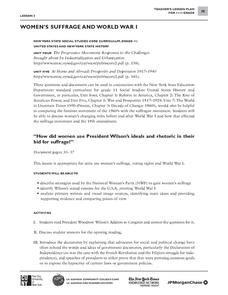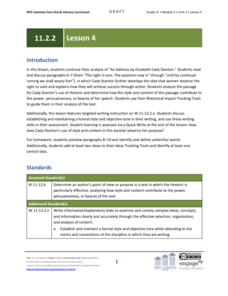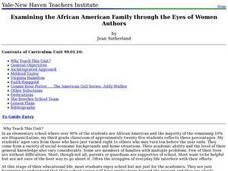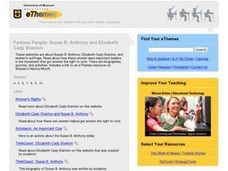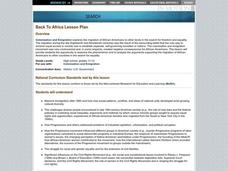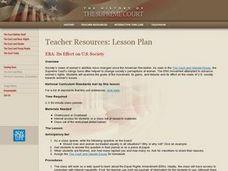EngageNY
Grade 10 ELA Module 2: Unit 1, Lesson 19
Great minds think alike. Scholars read two texts and compare how the authors develop the same central idea. Readers analyze "Women" by Alice Walker and "Letter from Birmingham Jail" by Martin Luther King Jr. They discuss word use and new...
Curated OER
Ordinary People, Ordinary Places: The Civil Rights Movement
Students analyze Martin Luther King's message of nonviolent protest discover how individuals adapted his message to their own communities and situations.
Curated OER
Before Rosa Parks: Ida B. Wells
The contributions of Ida B. Wells to the Civil Rights Movement are the focus of this social studies instructional activity. Middle schoolers read a handout regarding Wells, discuss the handout, and write about non-conformist behavior.
National Woman's History Museum
Stacey Abrams: Changing the Trajectory of Protecting People’s Voices and Votes
In this project-based learning lesson, young social scientists investigate Stacey Abrams' campaign to protect the voting rights of people across the nation. Investigators learn how to annotate assigned articles, watch videos, and collect...
City University of New York
Woman's Suffrage and World War I
How did women use President Wilson's ideals and rhetoric in their bid for suffrage? To answer this essential question, class groups analyze primary written documents and visual images.
EngageNY
Grade 11 ELA Module 2: Unit 2, Lesson 4
How does style contribute to the power and persuasiveness of a speech? With the question in mind, scholars continue reading "An Address by Elizabeth Cady Stanton." They complete a Rhetorical Impact Tracking Tool to guide them in their...
NPR
Female Olympians Lesson Plan
For every strong and determined female Olympian, there are millions of young girls watching and becoming inspired. Middle and high schoolers learn more about record-breaking and history-making Olympian women with a presentation from the...
Smithsonian Institution
What's the Code? Coding Robot Movements Using Sound
Tap into the desire to learn about computer codes. Pupils apply the Tap Code and the Polybius Square to send secret codes using sound. They design a code that tells a robot what movements to make and then test out their code using one of...
Curated OER
The Nineteenth Amendment: Susan B. Anthony
What would your scholars do if Susan B. Anthony walked into class? Shock them to attention with this instructional activity, which has the school secretary (or any willing participant) dress as the famous suffragette and answer questions...
Curated OER
Examining the African American Family through the Eyes of Women Authors
Students read stories by women authors on the characteristics of the African-American family. Using the internet, they research the history of issues that have affected African-American families from the Civil War to the Civil Rights...
Curated OER
Role Model Medal
Students investigate positive female role models. In this Women's History Month lesson, students read the book Mama Went to Jail for the Vote and think about how the character was a role model for other women. Students brainstorm a woman...
Curated OER
FAMOUS PEOPLE: SUSAN B. ANTHONY AND ELIZABETH CADY STANTON
Students explore websites are about Susan B. Anthony, Elizabeth Cady Stanton, and women's suffrage and read about how these women were important leaders in the movement that got women the right to vote.
Curated OER
Women Suffered to Achieve Suffrage
Students compare and contrast the movement for suffrage in Nebraska and the U.S. They organize and interpret primary documents and images from the time period. In addition, they tie in religious movements to women's suffrage.
Curated OER
Women in Progressive Era
Learners study the Progressive Era. They identify the important people, places, and evens of the Era and determine how women influenced the progressive movement. In addition, they create an article to address issues related to the movement.
Curated OER
The arly Suffragists
Students explore the suffragist movement through this futuristic instructional activity about the loss and creation of a commemorative stamp to honor a women's Suffrage Pioneer. The instructional activity takes us to 2080 and back to the...
Curated OER
Charolotte Perkins Gilman's "The Yellow Wall-paper" - the "New Woman"
Students analyze the life of American middle to upper-class women in the mid- to late-nineteenth century and early twentieth century. In this women's suffrage lesson, students visit the given links in the lesson to analyze the changing...
Curated OER
Back To Africa
Learners analyze the massive immigration after 1850 and how new social patterns, conflicts, and ideas of national unity developed amid growing cultural diversity, and how the Progressive movement influenced different groups in American...
Curated OER
ERA: Its Effect on U.S. Society
Students student the goals of the ERA movement as it attempted to advance women's rights. They examine its goals, gains, and shortcomings.
Curated OER
Children's March Teacher's Guide, Activity 6
Pupils see the role that different genders played in the Civil Rights Movement in Birmingham. They explain how popular culture influences them.
Curated OER
America's Civil Rights Movement, Activity Four
Students investigate the concept that people died during the Civil Right;s Movement using the Matix method.
City University of New York
The Split Over Suffrage
Compare and contrast Frederick Douglass's and the National Women's Suffrage Association's stances on equal rights and suffrage with a series of documents and worksheets. Learners work together or independently to complete the packet, and...
US National Archives
Susan B. Anthony and the Struggle for Suffrage
Susan B. Anthony was willing to break the law to gain voting rights for women. Young historians investigate Anthony's willingness to go to jail to draw attention to the suffrage movement. They read and discuss primary source documents to...
New York State Education Department
US History and Government Examination: June 2010
Just how successful were the reform movements of the ninteenth and twentieth centuries? Using documents ranging from the writings of Mother Jones to the marriage vows of Lucy Stone, individuals consider the question in a scaffolded...
National Woman's History Museum
State vs. Federal Campaigns
Campaigns to gain voting rights for women during the 19th and 20th centuries took place on both the state and federal level. After examining primary sources that document both types of campaigns, class members debate the merits of the...






